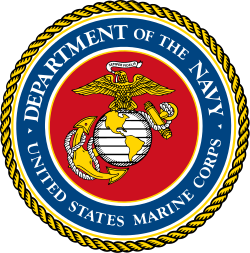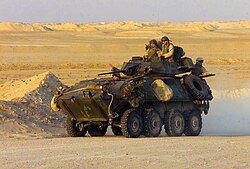Námořní pěchota Spojených států amerických
| United States Marine Corps Námořní pěchota Spojených států amerických | |
|---|---|
 Kotva, glóbus a orel - emblém Mariňáků | |
| Země | |
| Existence | 1775 – 1783 1798 – současnost |
| Typ | Námořní pěchota |
| Funkce | Obojživelná a rychle nasaditelná úderná síla |
| Velikost | přibližně 245 000 lidí |
| Motto | Semper fidelis (vždy věrní) |
| Nadřazené jednotky | Ozbrojené síly USA Ministerstvo obrany Úřad námořnictva |
| Webová stránka | www |
| Insignie | |
| Znak |  |

Námořní pěchota Spojených států amerických (United States Marine Corps, zkratkou USMC, často označovaná jen US Marines, česky též Mariňáci) je složka námořní pěchoty v rámci Ozbrojených sil USA. Je jednou ze šesti ozbrojených složek USA a jednou z osmi uniformovaných složek USA. Je odpovědná za provádění expedičních a obojživelných operací[1] prostřednictvím kombinovaných zbraní, zahrnujících vlastní pěchotu, dělostřelectvo, letectvo a speciální operační síly. Používá rovněž bojové letouny, vrtulníky, tanky a různá bojová vozidla. Námořní pěchota provozuje základny na pevnině i na lodích určených k obojživelným válečným operacím po celém světě. Kromě toho provozuje několik leteckých eskader, zejména eskadry stíhacích bombardérů, je rovněž součástí leteckých křídel námořních letadlových lodí a operuje z těchto lodí.[2]
Historie námořní pěchoty Spojených států začala 10. listopadu 1775, kdy byly ve Filadelfii vytvořeny dva prapory Kontinentální námořní pěchoty jako složka pěchoty schopná bojovat jak na moři, tak na pevnině.[3] Námořní pěchota se zejména proslavila pomocí jejího obojživelného boje za druhé světové války proti Japonsku.
Od svého vzniku má Námořní pěchota specifické postavení mezi ozbrojenými složkami. Na rozdíl od například britských Royal Marines, kteří jsou součástí Námořnictva,[4] či francozských Troupes de marine, kteří jsou součástí Armády,[5] jsou američtí námořní pěšáci zcela nezávislý ozbrojený sbor s vlastní kulturou a historií. Příslušník Námořní pěchoty tak je mariňák (anglicky Marine) a nikoliv voják (anglicky Soldier) ani námořník (anglicky Sailor).[6] Přesto Námořní pěchota sdílí určité prvky jak s pozemním vojskem, tak s loďstvem. Například stejně jako Námořnictvo (a v době války i Pobřežní stráž[7]) je v rámci ministerstva obrany podřízena odboru námořnictva (Department of the Navy), ale používá armádní systém hodností, kde nejvyšší je generál (na rozdíl od námořnictva, kde je nejvyšší admirál). Má také významné postavení ve vztahu k prezidentovi jakožto vrchnímu veliteli Ozbrojených sil, kterému poskytuje služby vrtulníkové přepravy (takový vrtulník pak má volací znak Marine One), vojenská kapela Námořní pěchoty doprovází prezidenta na oficiálních akcích[8] a vybraní důstojníci plní protokolární funkce v Bílém domě.[9]
Od roku 2002 používá Námořní pěchota nové uniformy s digitální kamufláží MARPAT v lesní, pouštní, a nově i sněžné verzi. Tyto uniformy nahradily starší Battle Dress Uniform. K prosinci 2024 má USMC přibližně 169 000 aktivních příslušníků[10] a zhruba 33 000 rezervistů.[11] V roce 2016 provozovala 1199 letadel.[12]
Historie
Námořní pěchota Spojených států považuje za datum svého vzniku 10. listopad 1775, kdy kapitán Samuel Nicholas vybudoval z pověření Druhého kontinentálního kongresu Continental Marines. Ti ovšem byli po skončení americké války za nezávislost v roce 1783 rozpuštěni. K obnovení (znovuzaložení) Námořní pěchoty Spojených států došlo 11. července 1798 s počátkem tzv. kvaziválky s revoluční Francií.
Námořní expediční uskupení
Unikátním prvkem pro Námořní pěchotu je, že na rozdíl od armády a ostatních složek amerických ozbrojených sil používá kombinované síly - tzn. jak pozemní jednotky, tak vzdušné a podpůrné. Toho je využíváno hlavně v Marine Expeditionary Units (MEU), což jsou jednotky o počtu zhruba 2200 vojáků, několika pozemních a obojživelných vozidel, helikoptér a letadel, rozmístěných na letadlových lodích, schopné rychlého nasazení kdekoliv na světě.
Fotogalerie
- Mariňák s lehkým kulometem M249 SAW
- Příslušník Námořní pěchoty s M16
- Kolona bojových vozů HUMVEE v Iráku
- Tank M1 Abrams, používaný Námořní pěchotou
- AV-8B Harrier II
- Vrtulník AH-1Z Viper, hlavní útočná helikoptéra USMC
- Letoun F/A-18 Hornet, rovněž ve výzbroji Námořní pěchoty
- Mariňáci při operaci Ocelová opona
- Přehled uniforem-zleva: bojová uniforma MCCUU, blue dress, služební uniforma a večerní uniforma
- Obrněný transportér LAV-25
- 155mm houfnice M777 během cvičení v Norsku
- Salvový raketomet HIMARS při cvičné palbě z paluby dokové výsadkové lodi USS Anchorage
Odkazy
Reference
- ↑ KRULAK, Charles C. Operational Maneuver from the Sea [online]. [cit. 2025-04-07]. Dostupné v archivu pořízeném z originálu dne 2006-08-11.
- ↑ Air Wings Built for Two. Air & Space Forces Magazine [online]. [cit. 2025-04-07]. Dostupné online. (anglicky)
- ↑ U.S. Marine Corps Decade Timeline [online]. [cit. 2025-04-07]. Dostupné v archivu pořízeném z originálu dne 2013-10-01.
- ↑ THE ROYAL NAVY’S SURFACE FLEET [online]. [cit. 2025-04-07]. Dostupné v archivu pořízeném z originálu dne 2012-10-18.
- ↑ Troupes de marine | Ministère des Armées. www.defense.gouv.fr [online]. 2022-04-25 [cit. 2025-04-07]. Dostupné online. (francouzsky)
- ↑ Don't call a Marine a soldier or sailor. Connecticut Post. 2005-09-25. Dostupné v archivu pořízeném z originálu dne 2021-03-24. (anglicky)
- ↑ REP. YOUNG, Don [R-AK-At Large. H.R.889 - 109th Congress (2005-2006): Coast Guard and Maritime Transportation Act of 2006. www.congress.gov [online]. 2006-07-12 [cit. 2025-04-07]. Dostupné online.
- ↑ Marine Band and the Presidents [online]. [cit. 2025-04-07]. Dostupné online.
- ↑ White House Military Social Aides. WHHA (en-US) [online]. [cit. 2025-04-07]. Dostupné online. (anglicky)
- ↑ Active Duty Military Personnel by Rank/Grade and Service [online]. Ministerstvo obrany USA [cit. 2025-04-07]. Dostupné v archivu pořízeném z originálu dne 2025-03-06.
- ↑ Selected Reserves by Rank/Grade [online]. Ministerstvo obrany USA [cit. 2025-04-07]. Dostupné v archivu pořízeném z originálu dne 2025-03-06.
- ↑ World Air Forces 2017. Flightglobal. S. 17. Dostupné online [cit. 10 February 2017].
Související články
- United States Marine Corps Aviation
- Hymna americké námořní pěchoty
Externí odkazy
 Obrázky, zvuky či videa k tématu Námořní pěchota Spojených států amerických na Wikimedia Commons
Obrázky, zvuky či videa k tématu Námořní pěchota Spojených států amerických na Wikimedia Commons - Oficiální stránky
- (anglicky) Oficiální náborové video
- (anglicky) Náborové video "No compromises"
- (anglicky) Náborové video "Leap"
- (anglicky) U.S. Marine Corps in World War II
Média použitá na této stránce
Private Jonathan Clendenin fires his M-249 Squad Automatic Weapon January 30 at the Oyanohara Maneuver Area, Kyushu, Japan, during Exercise Forest Light 2007.
Photo ID: 200728203243
Submitting Unit: Marine Corps Base Camp ButlerSeal of the United States Marine Corps. It is defined in Executive Order 10538 (alternate source) as:
For more information, see here.Standing upon the western hemisphere of the terrestrial globe containing the lines of latitude and topographical outlines of North, Central, and South America, an American bald eagle with wings displayed horizontally and inverted holding in his beak a scroll inscribed with the motto SEMPER FIDELIS, all bronze. Behind the western hemisphere a foul anchor bend sinister-wise with stock, arms, and flukes in slight perspective, all bronze, on a scarlet background and within a dark blue band edged in gold circumscribed by a gold rope rim and inscribed DEPARTMENT OF THE NAVY • UNITED STATES MARINE CORPS in gold letters. The central device of the seal is the emblem of the United States Marine Corps.
Autor: Paul Maritz en:User:Paulmaz, edited by Fir0002, Licence: CC BY-SA 3.0
A U.S. Marine Corps Boeing AV-8B+(R)-27-MC Harrier II Plus (BuNo 165597) from Marine attack squadron VMA-231 Ace of Spades at the EAA AirVenture Convention at Oskosh, Wisconsin (USA), in 2003. The AV-8B+ 165597 had originally been built as a standard AV-8B (BuNo 163678) and was later converted to an AV-8B+.
A convoy of U.S. Marine Corps (USMC) High-Mobility Multipurpose Wheeled Vehicles (HMMWV), assigned to D/Company, 1st Light Armored Reconnaissance Battalion, 1st Marines Division, arrives in Northern Iraq, during a sandstorm. USMC personnel are in Iraq in support of Operation IRAQI FREEDOM. Several vehicles are equipped with Tube-launched Optically-tracked Wire-guided (TOW) missile launchers.
Pilots with Marine Light Attack Helicopter Training Squadron 303, Marine Aircraft Group 39, 3rd Marine Aircraft Wing maneuver a AH-1Z Viper belonging to the squadron during training aboard Marine Corps Base Camp Pendleton, Calif. Dec. 19, 2008. The new Cobra can twice the number of missiles while being able to travel almost twice as far. (U.S. Marine Corps photo by Lance Cpl. Christopher O'Quin) (Released)
Collage of United States Marine Corps uniforms, made from combining individuals from plates I, IV, V, and XIV of the USMC uniform plates series
021002-M-2706G-003 Central Command Area of Operation (Oct. 2, 2002) -- Marines with Company D, Light Armored Reconnaissance, Battalion Landing Team 3/1, 11th Marine Expeditionary Unit (MEU) (Special Operations Capable), focus down range during recent live-fire training. With the aid of their Light Armored Vehicle Two Five (LAV-25), the Marines can undertake a number of missions, to include facilitating reconnaissance, artillery direction and ‘hit and run missions.’ Each LAV-25 is equipped with a 25mm chain gun and two M-240E1 machine guns, enabling the Marine gunners to accurately fire on targets while moving at speeds of up to 10 mph due to the vehicle's stabilization system. U.S. Marine Corps photo. (RELEASED).
A M142 High Mobility Artillery Rocket System (HIMARS) is fired from the flight deck of the U.S. Navy amphibious transport dock ship USS Anchorage (LPD-23) during exercise "Dawn Blitz 2017" over the Pacific Ocean on 22 October 2017. "Dawn Blitz" is a scenario-driven exercise designed to train and integrate Navy and Marine Corps units by providing a robust training environment where forces plan and execute an amphibious assault, engage in live-fire events, and establish expeditionary advanced bases in a land and maritime threat environment to improve naval amphibious core competencies.
Caption: A Marine with Company I, 3rd Battalion, 5th Marine Regiment, sights in on his M-16A2 automatic service rifle during tank integration training with Company C, 2nd Tank Battalion, at Camp Baharia, Iraq, Nov. 2.
- Photo by: Sgt. Luis R. Agostini
- Photo ID: 200411334517
- Submitting Unit: 1st Marine Division
- Photo Date:11/02/2004
STEEL CURTAIN — U.S. Marine Corps Lance Cpl. Steven L. Phillips stands with his shotgun ready to advance if called, near Camp Al Qa'im, Iraq, Nov. 15, 2005. Behind him in support is Lance Cpl. Paul J. Kolkhorst. Both Marines are anti-tank assaultmen and participated in Operation Steel Curtain. U.S. Marine Corps photo
Marines with Combined Arms Company, await the confirmation call of a round impact during a live-fire shoot in Rena, Norway, Feb. 23, 2016, in preparation for Exercise Cold Response 16. The exercise will include 12 NATO allies and partner nations, and approximately 16,000 troops. The Marines will act as support for the infantry battalions during the exercise. The Marines will provide indirect fire support for infantry units during the exercise.
The security element of the 31st Marine Expeditionary Unit’s Maritime Special Purpose Force provides blocking positions near a simulated target site here Aug. 8 as part of Training in an Urban Environment Exercise or “TRUEX.” The Maritime Special Purpose Force is a composite unit made up of Marines and sailors from the MEU’s Battalion Landing Team, 1st Battalion, 5th Marine Regiment, and the command element’s Deep and Amphibious Reconnaissance Platoons.
Photo by: Lance Cpl. Kamran Sadaghiani Photo ID: 2006891530 Submitting Unit: 31st MEU
Photo Date:08/08/2006U.S. Marines perform premission checks on an M1A1 Abrams Tank in Camp Fallujah, Iraq, January 21, 2007.
U.S. Marine Corps Captain Kevin Reece of Marine Fighter Attack Squadron 212 (VMFA-212), pilots his McDonnell Douglas F/A-18C Hornet over the South China Sea on the return trip from Paya Lebar, Singapore to Marine Corps Air Station (MCAS) Iwakuni, Japan, in support of exercise "Commando Sling" on 8 October 2003.


























